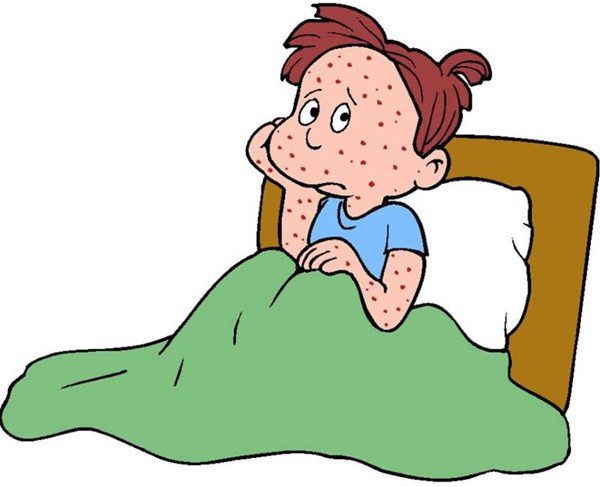Chickenpox is an infectious disease caused by the Varicella Zoster virus and commonly outbreaks in the spring. Individuals suffering from chickenpox who do not receive proper care and treatment may face dangerous complications.
Important Information About Chickenpox
Is chickenpox contagious?
Chickenpox is caused by a virus known as the Varicella Zoster Virus (VZV) and is highly contagious.
- The virus spreads primarily through respiratory droplets (or airborne transmission); healthy individuals are easily infected by inhaling droplets expelled when a chickenpox patient coughs, sneezes, or talks, especially children.
- Other ways of transmission may occur if we are not careful when coming into contact with a chickenpox patient, such as transmission from broken blisters, or from damaged or ulcerated skin of the infected person. Particularly, pregnant women who unfortunately contract the disease are at a high risk of transmitting it to the fetus through the placenta.
Symptoms of chickenpox
- At the onset, the patient may experience symptoms such as fever, headache, muscle aches, and in some cases, especially in children, there may be no alarming symptoms…
 During chickenpox, the patient’s body will develop ‘pox’.
During chickenpox, the patient’s body will develop ‘pox’.
During chickenpox, the patient’s body will develop “pox.” These are small round spots that appear quickly within 12 – 24 hours, progressing to blisters.
- Afterward, the patient will develop small round spots known as “pox.” These spots appear rapidly within 12 – 24 hours, progressing into blisters. Pox can appear all over the body or scattered, averaging about 100 – 500 spots. Normally, these blisters dry up, form scabs, and heal completely within 4 – 5 days. In children, chickenpox often lasts about 5 – 10 days, leading to school or daycare absences.
Complications of chickenpox
Generally, chickenpox is a benign disease. However, it can cause dangerous complications such as meningitis, bleeding, sepsis, infections in the pox, cellulitis, hepatitis, and more. In some cases, it can be fatal if the patient does not receive timely treatment. A mother contracting chickenpox during pregnancy may give birth to a child with congenital disabilities later.
Pneumonia caused by chickenpox occurs less frequently but is severe and difficult to treat. Encephalitis due to chickenpox can also occur, and it is not rare: after chickenpox, a child may suddenly become restless, exhibit tremors, and sometimes have seizures (convulsions) or coma. These cases can lead to rapid death, and some children who survive may still carry long-term neurological sequelae: deafness, cognitive impairment, epilepsy, etc.
Caring for individuals with chickenpox
- Since chickenpox is contagious, when a child has chickenpox, the first step is for parents to isolate the child at home until they fully recover. Supplement vitamin C, administer nasal drops twice a day for the child. Dress the child in soft, absorbent clothing, and pay special attention to maintaining good skin hygiene to avoid complications. Keep the child’s hands clean.
 When needing to contact a chickenpox patient, a mask should be worn.
When needing to contact a chickenpox patient, a mask should be worn.
When needing to contact a chickenpox patient, a mask should be worn. After contact, wash hands immediately with soap. Especially, pregnant women must absolutely avoid contact with infected individuals.
Note: Avoid breaking the chickenpox blisters, as it may lead to secondary infections and long-lasting scars.
- Stay in a separate, ventilated room with sunlight; the isolation period is approximately 7 to 10 days from the onset of the disease (rash) until all blisters are dry and crusted (adults must take time off work, and students must take time off school).
- Use separate personal hygiene items: towels, cups, bowls, spoons, and chopsticks.
- Daily clean the nasal passages and throat with a saline solution.
- Change clothes and bathe daily with warm water in the bathroom.
- Wear loose, light, thin clothing.
For children
- Trim the child’s nails, keep them clean, or use cloth mittens to cover the child’s hands to prevent secondary skin infections caused by scratching at the blisters.
- Provide soft, liquid, easily digestible foods, and ensure they drink plenty of fluids, especially fruit juices.
- Use Milian green solution (Methylene blue) to apply on broken blisters.
- In case of high fever, common fever-reducing medications can be used, but must follow the doctor’s guidance; antibiotics may be used if the pox are infected: blisters with pus, redness around the skin… Absolutely do not use aspirin to reduce fever.
- If the patient feels discomfort, lethargy, fatigue, seizures, coma, or has bleeding on the pox, they should be taken to a medical facility immediately for monitoring and treatment.

Chickenpox is a benign disease but needs to be detected early and carefully managed; otherwise, complications can be very dangerous.
For family members:
- Limit contact with the patient: When contact is necessary, wear a mask. After contact, wash hands immediately with soap. Especially, pregnant women must absolutely avoid contact with infected individuals.
- Clean the patient’s living area: Daily wipe down the floors, furniture, toys with Javel water or Cloramin B solution, then rinse with clean water. Small items can be sun-dried.
Doctors recommend that while chickenpox is a benign disease, it must be detected early and cared for adequately; otherwise, failure to receive timely and proper treatment can lead to many dangerous complications such as pneumonia, encephalitis, and meningitis. Therefore, it is essential to base the diagnosis on the symptoms of the disease for timely detection and treatment.

There are now proactive measures to prevent chickenpox, which include vaccination.
Preventing Chickenpox
Although the disease can spread rapidly within the community, there are now proactive measures to prevent chickenpox through vaccination. For children aged 12 months to 12 years, one dose is given, and a second dose should be administered 6 weeks or more after the first dose, or between 4 – 6 years old to enhance the effectiveness of prevention and reduce the chances of contracting chickenpox again even if previously vaccinated. For individuals over 13 years old, adolescents, and adults, 2 doses should be given, ideally spaced 6 weeks apart.
According to the Da Nang Center for Preventive Medicine, the vaccination schedule for chickenpox is as follows:
- Administer the first dose for everyone aged 12 months and older.
- Administer the second booster dose at least 6 weeks after the first dose (do not administer 2 doses spaced 4 weeks apart).
Note:
- Do not administer chickenpox vaccine to pregnant women.
- Women of childbearing age (15 to 49 years old) should receive the chickenpox vaccine at least 3 months before becoming pregnant.
Facts About the Two Popular Medications for Chickenpox: Green and Red
Dr. Hoang Van Tam, a lecturer in the Dermatology Department at Hanoi Medical University, shares: “When infected with chickenpox, patients often fear superinfection. Superinfection on the skin can easily lead to bacterial infections in other organs and cause scarring due to chickenpox. This is why many people tend to buy Castellani (red) or Methylene blue (green) to apply on the chickenpox spots because of their antibacterial properties. However, according to Dr. Tam, this is a mistake.”
The Real Effects of Castellani and Methylene Blue
Dr. Tam explains that Castellani contains components such as: Basic fuchsin (with antibacterial and antifungal properties); Ethyl alcohol (provides a cooling effect); Acetone (cools and cleans); and Resorcinol (anti-itch, keratolytic, antifungal).
However, this medication also contains two potentially toxic components: Boric acid and Phenol. “Boric acid has antibacterial properties, but it is rarely used in topical medications today because when absorbed, it becomes toxic. Phenol, at low concentrations, inhibits nerve endings and has an anti-itch effect. However, at high concentrations over large areas, they can be toxic to the body, especially to the kidneys. It can cause kidney damage if used on infants and young children,” Dr. Tam informed.
Castellani is primarily indicated for treating groin fungus and intertrigo due to Candida, especially in individuals using corticosteroids long-term. However, this indication is mainly for small areas only.
Dr. Tam advises that for chickenpox, people only need to use topical antibiotic ointments or creams if there is a superinfection. In cases of systemic superinfection, oral antibiotics are necessary.
Regarding Methylene blue, the expert states that this medication has only one component and can be used for certain conditions (orally or injected) and is relatively safe. However, there is no evidence of its effectiveness in treating chickenpox, while the visible drawback of using this medication is that it can stain the skin and clothes.
“Recently, many people shared images of a child with chickenpox who had a greenish face. I advise the public not to do the same; although this medication is safer, it is messy, and its antibacterial effectiveness is negligible,” Dr. Tam concluded.


















































